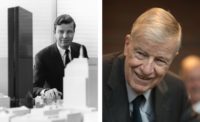William Menking, who founded The Architect’s Newspaper (A/N) with his wife, Diana Darling, in 2003, died at age 72 on April 11, 2020, after a long battle with lymphoma. As editor-in-chief of A/N, he wrote hundreds of editorials over the past 17 years, many reflecting his deeply held views about how architects could make the world a better place. “Bill believed that architects are really well-meaning, and he inspired people to step up,” said Sharon Prince, CEO of the Grace Farms Foundation, who worked with Menking on a program to eliminate forced labor in the production of building materials.

Menking was an indispensable part of the architecture world long before he and Darling launched the newspaper, the only one of its kind in the U.S. He was an author and curator with a particular interest in the radical architecture movements of the 1960s and 70s. Barry Bergdoll, professor at Columbia University and former chief curator of architecture and design at the Museum of Modern Art, described Menking’s 1998 New York show about Archigram as an “amazing spectacle of huge drawings, wall-to-wall and almost floor-to-ceiling, at a moment when interest in the radical architecture of the ‘60s was not in full swing as it is today. In this and in so many things,” Bergdoll told RECORD, “Bill was ahead of the curve.”
Menking taught at Pratt Institute for nearly 30 years. Luca Viverito, a student who took his required first-year course in History and Theory in 2018, remembers, “Watching him in the classroom, you got the impression that he knew everything you would ever need to know in life.” When Harriet Harriss became dean of architecture at Pratt last year, “Bill called me up to offer a thoroughly unorthodox appraisal of what I needed to know to do the job,” she recalled. “He was always insightful and refreshingly free from artifice.”
The lack of artifice may be the result of a childhood in California’s Central Valley, where he helped guide crop dusters and once played football against O.J. Simpson; later he worked there as an organizer for the United Farm Workers. He studied architecture at the University of California, Berkeley, and traveled abroad to meet the leaders of radical movements such as Archizoom Associati, Superstudio, and Gruppo UFO, which informed his future scholarship. Moving to New York, he worked briefly as a waiter at the legendary disco Studio 54 and then as a film location scout, according to A/N, which detailed his early exploits in an obituary. Later, he worked on the hit TV show “Miami Vice,” which used the city’s bold contemporary architecture as a backdrop. In the 1990s, he studied at the Bartlett School of Architecture in London and wrote for the British publications The Architects’ Journal and Building Design. That gave him the idea for The Architect’s Newspaper, which he and Darling started in their TriBeCa loft.
His belief that architecture should be a tool for social justice was clear in all of his endeavors. As commissioner of the U.S. Pavilion at the 2008 Venice Architecture Biennale, he organized a show on the cultural, geopolitical, and architectural implications of mass migration. “It was the first U.S. pavilion to present American architecture from the community-based, bottom-up point of view that he was passionate about,” recalled his Pratt colleague Deborah Gans. (In 2010, he published “Architecture on Display: On The History of the Venice Biennale of Architecture,” co-edited with Aaron Levy.) Menking was on the board of directors at the Storefront for Art and Architecture and was the former board chair for The Architecture Lobby, which advocates for improved working conditions in the profession.
“He spoke truth to power in a profession saturated with elitism and the cult of personality,” said Walter Meyer, who with his wife Jennifer Bolstad taught at Pratt and considered Menking a mentor. “He empowered a generation of architecture graduates with tools to address equity through design.”
He maintained his devotion to “architectural justice” even during his protracted illness. Frances Bronet, the president of Pratt, remembers him driving her to Grace Farms for a meeting on the forced-labor initiative. In a note thanking Menking afterwards, she wrote, “I will never forget your adventurousness, your commitment, your gregariousness, your generosity. You transferred your ambitions for a better world to me in just one day.”





Post a comment to this article
Report Abusive Comment